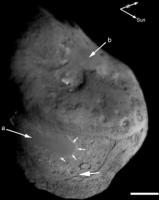Comet Tempel 1, the target of NASA’s Deep Impact probe back in July, has offered scientists a stunning view of cometary topography. The first published results from the mission team will appear in the September 9 issue of Science and have been released at the Division of Planetary Sciences meeting at Cambridge. Among other things, Tempel 1 is the first comet to demonstrate impact craters, an indication of collisions with various space debris over the aeons.
The craters range from 40 to 400 meters across, but are they common to all comets? Those we’ve had good views of, including Borelly and Wild 2, show significant differences in topography and shape. Of Tempel 1, we can only say that its lifetime has been complex. “This comet is a geologic wonder,” said Peter Schultz, a professor of geological sciences at Brown University and a co-investigator on the mission team. “There are smooth surfaces, filled-in craters, ridges, cliffs. Tempel 1 also features an area marked by innumerable bumps and valleys. This all suggests a long history of evolution.”
 More on Schultz’ comments in this Brown University news release. Meanwhile, the topographical wonderland of Tempel 1 is not only fascinating but vexing. Deep Impact principal investigator Dr. Michael A’Hearn (University of Maryland), admits to being surprised at what he has seen. “The problem in stating with certainty that these are impact craters is that we don’t know of a mechanism by which some comets would collide with the flotsam and jetsam in our solar system, while others would not,” A’Hearn said.
More on Schultz’ comments in this Brown University news release. Meanwhile, the topographical wonderland of Tempel 1 is not only fascinating but vexing. Deep Impact principal investigator Dr. Michael A’Hearn (University of Maryland), admits to being surprised at what he has seen. “The problem in stating with certainty that these are impact craters is that we don’t know of a mechanism by which some comets would collide with the flotsam and jetsam in our solar system, while others would not,” A’Hearn said.
Image (click to enlarge): This composite image was built up from scaling all images to 5 meters/pixel, and aligning images to fixed points. Each image at closer range, replaced equivalent locations observed at a greater distance. The impact site has the highest resolution because images were acquired until about 4 sec from impact or a few meters from the surface. Credit: NASA/JPL/UMd.
Rather than being covered in a hard crust, Tempel 1 is coated with a fine-grained, fluffy powder apparently tens of meters deep. But while ice and organic dust were detected after the probe hit the comet, many of the organic compounds that make up the powder have yet to be identified. Painstaking months of analysis lie ahead. The issue is important because the substantial amount of carbon-containing molecules detected after impact corroborates the theory that comets may have contributed such material to the early Earth.
More is available in this NASA news release. Note especially this comment:
Mission data indicate the nucleus of Tempel 1 is extremely porous. Its porosity allows the surface of the nucleus to heat up and cool down almost instantly in response to sunlight. This suggests heat is not easily conducted to the interior and the ice and other material deep inside the nucleus may be pristine and unchanged from the early days of the solar system, just as many scientists had suggested.


Comet 9P/Tempel 1: Interpretation with the Deep Impact Results
Authors: Satoru Yamamoto, Hiroshi Kimura, Evgenij Zubko, Hiroshi Kobayashi, Koji Wada, Masateru Ishiguro, Takafumi Matsui
(Submitted on 12 Dec 2007)
Abstract: According to our common understandings, the original surface of a short-period comet nucleus has been lost by sublimation processes during its close approaches to the Sun. Sublimation results in the formation of a dust mantle on the retreated surface and in chemical differentiation of ices over tens or hundreds of meters below the mantle.
In the course of NASA’s Deep Impact mission, optical and infrared imaging observations of the ejecta plume were conducted by several researchers, but their interpretations of the data came as a big surprise: (1) The nucleus of comet 9P/Tempel 1 is free of a dust mantle, but maintains its pristine crust of submicron-sized carbonaceous grains; (2) Primordial materials are accessible already at a depth of several tens of cm with abundant silicate grains of submicrometer sizes.
In this study, we demonstrate that a standard model of cometary nuclei explains well available observational data: (1) A dust mantle with a thickness of ~1-2 m builds up on the surface, where compact aggregates larger than tens of micrometers dominate; (2) Large fluffy aggregates are embedded in chemically differentiated layers as well as in the deepest part of the nucleus with primordial materials. We conclude that the Deep Impact results do not need any peculiar view of a comet nucleus.
Comments: 11 pages, 1 figure, 1 table. ApJ letters, in press
Subjects: Astrophysics (astro-ph)
Cite as: arXiv:0712.1858v1 [astro-ph]
Submission history
From: Satoru Yamamoto [view email]
[v1] Wed, 12 Dec 2007 02:43:41 GMT (33kb)
http://arxiv.org/abs/0712.1858